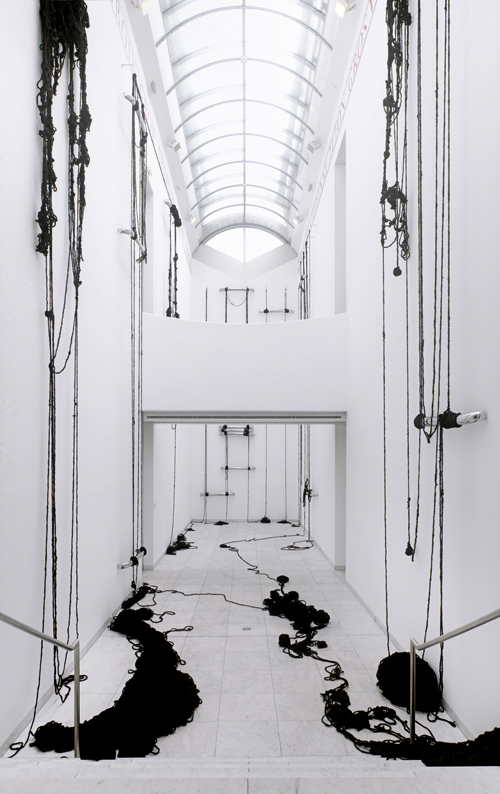Textiles
Do three recent German museum shows suggest a haptic antidote to our screen-based lives?
Do three recent German museum shows suggest a haptic antidote to our screen-based lives?

In the second half of 2013 alone there have been at least six exhibitions relating to textiles. Why now, and when did this trend begin? Renowned textile collector Seth Siegelaub who died unexpectedly last year, has had a marked influence, founding the Centre for Social Research on Old Textiles (CSROT) in 1986. Stuff Matters, an exhibition of historic textiles from his collection in early 2012 at London’s Raven Row was a front-runner of the current trend. At the same time, there has been an upsurge of interest in the use of fabric in contemporary art making. Does this, like the similar recent turn to ceramics, suggest a haptic antidote to our daily lives with its constant digital-feed and screen fixation? Or is it rather the continuation of an interest in the overlapping areas of fabric production and abstraction that has its roots in the early 20th century?

Three recent exhibitions in German museums consider this overlap both historically and in relation to contemporary work. Though each takes a slightly different approach to the theme, there are many crossovers; in argument, as well as artists and even works presented. For Rike Frank and Grant Watson, curators of Textiles: Open Letter. Abstractions. Textiles. Art at the Museum Abteiberg in Mönchengladbach, textiles are situated ‘between applied and “free” artistic practice, between craft and art’ and are ‘associated with female work, industrial labour, commodity, and trade.’ It is this agile state of contingency that makes the study of textiles so broad and so tricky to categorize. Frank and Watson’s exhibition grew out of a research project, borrowing its title from an essay by Bauhaus weaver Anni Albers. Choosing to focus solely on the woven structure, they construed a cohesively argued exhibition that was surprisingly non-medium specific, with books (from Siegelaub’s collection), photography, video and drawing providing relief from the haptic assault of stoff, while articulating the essential relationships between these different media. Still, hapticity was the point, conveyed as much by Beryl Korot’s 1977 three-channel video installation of Jacquard looms in action, as by Albers’ actual weaving from 1927, Lenore Tawney’s 1962 sculptural hangings, or floor-based woven nets from 2011 by Leonor Antunes. The show itself was just one facet of an ongoing discussion, however – accompanied by a series of talks in Mönchengladbach and a symposium in Bilbao – and will travel to the Generali Foundation in September 2014, to be concluded with a comprehensive publication.

A weighty catalogue was published concurrent with the opening of the Kunstmuseum Wolfsburg’s Art & Textiles. Fabric as Material and Concept in Modern Art from Klimt to the Present last October, but could not compete with the material richness of the exhibition itself: an ambitious, essayistic show packed with fascinating works that offered a sweeping historical perspective on the relation between textiles, art and daily life and the breadth of influence that textiles have had: early textile samples by William Morris; small, sumptuous paintings of decorated interiors by Éduard Vuillard; the recreation of the 1927 Café Samt & Seide by Ludwig Mies van der Rohe and Lilly Reich; a massive hanging sisal sculpture by Magdalena Abakanowicz and Gerhard Richter’s digitally woven recreation of an abstract painting, were interspersed with historic textile samples from ancient Egypt, ninth century China, 15th century Peru and the Congo in the 1800s. Women were well represented throughout, fortunately not just in the section dedicated to ‘feminist art’ (under the cringeworthy title ‘Spiderwomen’), while alignments were proposed between interests in canvas as raw material that emerged in the 1960s with Lucio Fontana or Blinky Palermo, and present day engagements by artists like Sergej Jensen. The erudite enthusiasm of curator Markus Brüderlin was infectious until the final section, which, through an overblown installation by video artist Peter Kogler, attempted to portray the ‘world wide web’ as ‘a kind of weaving loom of the internet age.’ The parallels that are doubtless there to be drawn would be more convincingly conveyed by artists on the cusp of this burgeoning Internet generation – like Nick Relph for example whose recent show at the Chisenhale Gallery presented a room of hand-woven panels as potential synonyms for the digital screens that dominate our lives.

Rosemarie Trockel, Alghiero e Boetti, Palermo, Polke, Fontana and Jensen – all of whom were included in the Wolfsburg show – cropped up again in To Open Eyes at the Kunsthalle Bielefeld, the exhibition title this time borrowed from Josef Albers. With the exception of Trockel, whose works were tucked away in a neighbouring annex, these were shown in a central first floor exhibition space in an all-male line-up strangely at odds with the argument made in the floor above about the marginalization of work made by female artists in the early and mid 20th century. On the second floor, a visually stunning multi-coloured Jacquard weaving by Bauhaus weaver Gunta Stölzl alongside a rarely shown Albers weaving were juxtaposed with a wonderful group of small-scale weavings by American artist Sheila Hicks from the 1960s to now. The inter-generational leap from works made in the 1920s to those in the ’60s went unremarked, however – symptomatic of a show which brought together a wide span of material with little further explanation. The generative contingency that contributes to the richness of textiles as subject matter necessitates the establishment and delivery of an argument in an exhibition of this kind; there is too much political history, gender politics, and social factors at stake to skim over such connections. As Siegelaub put it, there is an intimate relation between textiles and society, and this marks it out as a medium of particular fascination and endurance.














